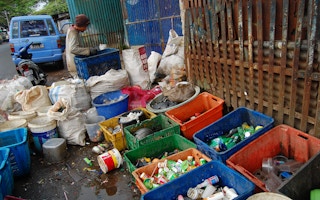We are only now learning how pollution impacts the base of our food web and the oxygen-producing plankton (phytoplankton) in our oceans. Phytoplankton use dissolved carbon dioxide (CO2) in our oceans to produce around 70 per cent of our oxygen. They singlehandedly remove a third of atmospheric CO2 in this way.
These very small creatures are sensitive to changes in their environment. As oceans become more acidic, they will need time to adapt. A possible scenario is changes in dominant species, numerous extinctions and pollution in surviving fishing stocks. The worst-case scenario is a catastrophic disruption to the base of oceanic food web, which currently feeds 1.4 billion people.
With so much at stake, why is so much plastic and other waste finding its way into oceans? Perhaps because waste is, by its nature, someone else’s problem.
But it’s a problem that isn’t going away. Over two-thirds of humanity is expected to live in urban areas by 2050. The challenge is to transition from our energy intensive, throw-away civilisation to a circular economy where resource conservation and effective waste disposal are top priorities.
To start, we need to admit that not all waste can be recycled. Some waste has an “end of life” at which point its disposal becomes urgent. Today, we have the technology not just to dispose of waste with minimal environmental impact, but to convert it into energy and other resources.
“
With so much at stake, why is so much plastic and other waste finding its way into oceans?
It wasn’t always that way. In the 1960s, the plastic bag probably ended up in a back-yard fire with highly toxic emissions. In the 1970s, an incinerator would have processed it, still spewing toxic fumes and ash. By the 2000s, many countries had opted for landfills with varying degrees of environmental controls. Recycling often involved burning plastics in uncontrolled conditions similar to old incinerators.
Today, the aim is to recover, recycle and reuse as much waste as possible. Most waste can be recycled if properly separated. The rest can be treated using new technology with air emissions 25,000 times less toxic than old incinerators. Most importantly, ash is captured, locked up and the pollutants stopped from entering waterways and oceans.
Japan is a world leader in waste-to-energy technology. These modern facilities emit just 20 per cent of the current stringent Japanese emission standard. This technology has been implemented in the People’s Republic of China (PRC) with ADB support over the last five years.
Ecoparks
Modern waste-to-energy mechanisms raise all sorts of possibilities. Ecoparks—industrial parks where businesses cooperate to reduce waste and turn byproducts into resources like energy—are transforming waste management.
Electricity, heat and steam can be shared among ecopark tenants to maximise resource recovery. Food waste, grey water, human septage, construction debris, medical and other waste can all be treated at ecoparks. We are supporting technologies to lock up pollutants and residues safely, stopping them reaching our oceans.
Ecoparks can shape consumer preferences for redesigned products and recyclable materials. Community based facilities in Spittelau, Austria and Ningbo in the PRC allow the public to see what happens to their waste. Manufacturers will respond to consumer preferences, especially as single use items attract more scrutiny.
As cities grow and recycling improves, smaller satellite ecoparks can treat organic materials and food waste, thereby curbing transport costs while keeping benefits like energy within the local area.
Digitisation of waste
The waste revolution isn’t confined to ecoparks. Digital technologies now allow trading apps to link with geographic information systems to provide big data opportunities to reduce collection costs and aggregate specific wastes for recyclers.
Imagine what Uber did for taxis being applied to local waste collectors and traders. ADB is engaging with apps like www.soluhq.com where consumers can segregate and sell their waste. We are exploring linking such apps to our GIS platform. As well as promoting better environmental services, this creates opportunities for unbanked people to access online services like banking and insurance.
Digitised waste collection can also boost government finances. Resource recovery charges can be levied on products based on their “end of life” costs. Companies will redesign their products and packaging to avoid these costs, while further cutting waste generation and sparing our oceans.
Ecoparks and digital technologies also open channels for a regional approach to waste. Strategically located ecoparks at ports on busy sea-lanes, like the Enerkem facility in Rotterdam, can shorten supply chains for tradeable waste products.
Asia’s waste crisis is a chance to reframe the region’s growth. With the latest technologies and bold thinking, we can transition to a circular economy and save our oceans.
Stephen Peters is a senior energy specialist at the Asian Development Bank. This article was first published by the Asian Development Bank.









